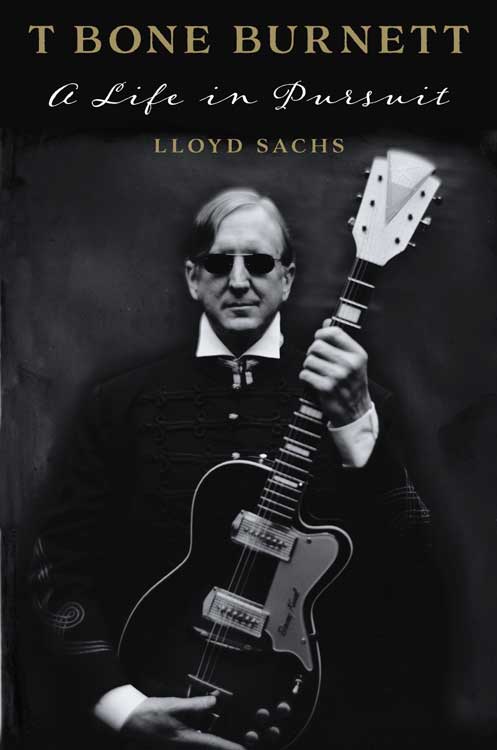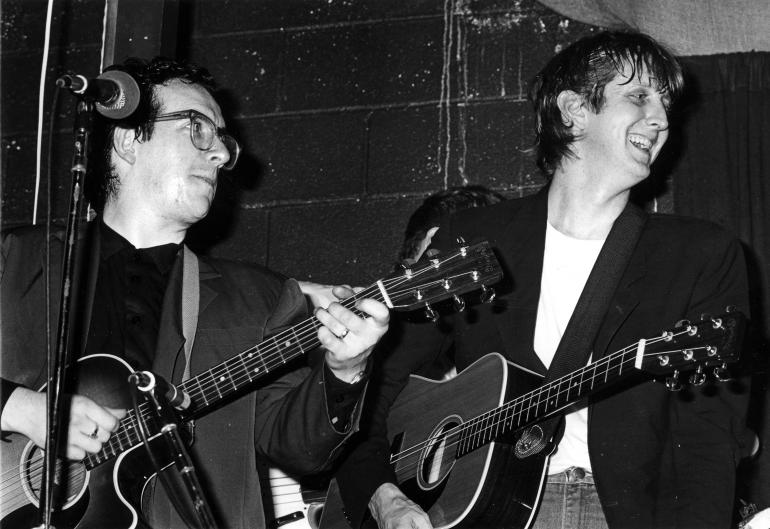During AmericanaFest in Nashville – on Thursday September 22 from 12:30-1:45 PM – Lloyd Sachs will read from and sign the very first book about T Bone Burnett, the legendary producer, singer-songwriter and soundtrack auteur, at Howlin’ Books.
Sachs will be joined at the legendary store, located at 1702 8th Avenue S, by the great T Bone protégé Joe Henry, who will sing a few songs by or associated with Burnett and discuss his experiences with him going back to Joe’s Burnett-produced masterpiece, Shuffletown. Henry will be performing at AmericanaFest on September 23-24 with Billy Bragg in support of their wonderful new album, Shine a Light.
For those who can’t make it to AmericanaFest, and for those who can, there will be a gala Chicago celebration of T Bone Burnett: A Life in Pursuit on Monday October 10 at 7 PM at the Hideout, the Windy City’s hippest club.
http://utpress.utexas.edu/index.php/boo ... ne-burnett

http://nodepression.com/article/opening-chorus

Burnett with Elvis Costello at McCabe’s Guitar Shop, Santa Monica, California, 1984. Photo by Sherry Rayn Barnett
OPENING CHORUS
On top of the world (or close)
BY LLOYD SACHS
SEPTEMBER 19, 2016
Fish were jumpin’ when T Bone Burnett conducted his first conference call with Alison Krauss and Robert Plant to discuss making an album together. The famed producer was up in Vancouver, British Columbia, at the Capilano Salmon Hatchery, perhaps thinking of Lou “The Salmon King” Kemp, the tour manager of Bob Dylan’s Rolling Thunder Revue. Surrounded by God’s wonders--steep granite cliffs, lush rainforest vegetation, roaring waterfalls--the spiritual seeker who some people think led Dylan down the path of Christianity was in an elevated state when he connected with Krauss, who was in Nashville, and Plant, who was in Bali--“or somewhere,” as Burnett would later say.
The geographical distance between the artists was a perfect metaphor for the vast stylistic distance between Krauss, a bell-toned sweetheart of modern bluegrass, and Plant, the leonine former wailer of Led Zeppelin. The thought of Krauss putting fiddle to the metal on “Black Dog” was only slightly odder than the thought of Plant going back porch. But Krauss, who grew up not in bluegrass country but in the university town of Champaign, Illinois, was a heavy metal fan. And Plant, a blues-loving native of England’s Midlands, was such a fan of hers that he had asked her to perform with him as part of the Rock and Roll Hall of Fame’s 2004 American Music Masters Tribute to Lead Belly.
“Singing that Lead Belly stuff wasn’t in the right range for us,” Krauss said in a 2008 press teleconference, according to the Cleveland Plain Dealer, but the encounter piqued the singers’ interest in further collaborations, and naturally led them to Burnett. He had recorded Krauss for O Brother, Where Art Thou?, the 2000 soundtrack album that ignited the roots music revival. And Burnett had been in talks with Plant about producing a sequel to The Honeydrippers: Volume One, the 1984 EP of fifties-era rock and R&B that the Brit recorded with his former Zep mate Jimmy Page. Krauss told Burnett that she wanted to do something darker than usual. Plant said he wasn’t interested in recording a conventional duo album. Leave it to Burnett to satisfy both their visions while surprising and challenging them with one of his own.
For Burnett, who with his vast knowledge of American music redefines the old throwaway line (and Dylan cover title) “I forgot more than you’ll ever know,” everything starts with the song. He went into full scuba mode, diving down deep into the vast stream of recorded history for tunes he envisioned Plant and Krauss covering. He came up not with a mere handful of singles and the like but with stacks of them. Listening to playlists ranging from the 1950s R&B group Li’l Millet and His Creoles’ tune “Rich Woman” to the prototypical alt-country artist Townes Van Zandt’s “Nothin’,” Plant felt as if he were attending a master’s class in spinology. “I thought I was pretty knowledgeable about American music, but I’d missed out on an entire area,” he told Jon Pareles of The New York Times. “I now know that American music is a total panorama. I was cutting it off and thinking it was redneck hell down there.”
Collaborations between well-known artists frequently go awry either because their styles don’t jibe (as with Eric Clapton & Wynton Marsalis Play the Blues), because there is too much of one star and not enough of the other (as with All the Roadrunning, on which Emmylou Harris disappears for long stretches opposite Mark Knopfler, who produced the recording), or because there no chemistry between them (as with virtually all the cuts on Frank Sinatra’s phoned-in Duets). Burnett, however, heard Raising Sand less as a collaboration than as a convergence -- a meeting of open-minded artists for whom one plus one equaled not two but one. If Plant and Krauss had any second thoughts about softening or departing from their signature styles to level the interpretive playing field, the relaxed atmosphere Burnett created in the studio enabled them to get past their doubts. Both were rewarded by finding sides of their talents of which they themselves had perhaps been unaware.
“I now know that American music is a total panorama. I was cutting it off and thinking it was redneck hell down there.” - T Bone Burnett
Plant was an obvious choice to sing Little Milton’s “Let Your Loss Be Your Lesson,” a mid-1970s B-side delight from the blues and R&B artist’s years with the Stax label. But Burnett asked Krauss to sing it instead. She initially begged off, feeling “too white” to do it (as she told National Public Radio’s Weekend Edition Sunday). Prodded by the producer, however, she rose to the challenge, bringing a soulful depth to what became a plucky, Loretta Lynn–type vehicle. Plant, rock’s quintessential lead singer, had rarely sung harmony, but opposite Krauss, a skilled arranger who showed him how to sing his parts, he sounds as pure as a choirboy. Their hushed communion on “Killing the Blues,” on which Greg Leisz’s sighing pedal steel arches over the singers like a rainbow over gold, is spine-tingling. Burnett first heard that song decades earlier when its composer, Roly (Rowland) Salley, Chris Isaak’s longtime bassist, played it in the Bay Area home of the Chicago-born bluesman Nick Gravenites.
As we will see, great music producers approach their work as uniquely as great film directors approach theirs, employing different methods to get the best performances out of their actors, different levels of formality to frame the performances, and different conceptions of the imprint they should or shouldn’t leave on the finished product. Burnett now carries such weight in the entertainment capitals of Hollywood and Nashville that the title “record producer” can contain him no more than “film director” could contain Orson Welles. His O Brother soundtrack altered the landscape of American music so markedly that it may well have affected our culture as significantly as Citizen Kane did. From his own critically acclaimed work as a singer and songwriter to his close associations with Bob Dylan and Sam Shepard -- one of the greatest songwriters of our time and one of the greatest playwrights--to his outspoken efforts to overhaul digital recorded sound, Burnett’s accomplishments have made the musician-producer one of the most significant figures in popular culture during the past forty years.
His success is particularly amazing because, in many ways, he is an outsider playing an insider’s game. A fierce intellectual, he finds cultural enrichment in a paradise of anti-intellectualism. A man of deep religious faith, he thrives in a den of moneylenders. Burnett is part Don Quixote, charging at digital windmills in his quest to restore analog truth, and part Southern politician, crossing palms with hyperbolic play money: he says that Justin Timberlake is “the closest we have to Bing Crosby,” claims the mandolinist Chris Thile is “the Louis Armstrong of his time,” and calls Alison Krauss “the one . . . [just as] Ray Charles was the one.”
For all that, Burnett has never been able to get past his own self-consciousness and self-doubt as a recording artist. While scoring success after big-time success for others -- whether breaking bands, such as Counting Crows, or reviving legends, such as Elton John -- he is stuck as a singer-songwriter on the mezzanine level of critics’ favorite. As acclaimed as some of his albums are, they have all withered on the commercial vine. That the once rail-thin, six-foot-five Texan has never been comfortable performing before crowds hasn’t helped.
That isn’t to say he hasn’t invested each of his own albums with high hopes. Such was the case with his 2006 effort, The True False Identity -- his first album under his own name in fourteen years, and, alas, his most recent one at this writing. Standing in an alley outside Chicago’s Vic Theater that May, a few hours before launching his first concert tour in nearly twenty years, he was wired with expectation. With a newspaper photographer preparing to take aim, he fidgeted against a brick wall, tugging at a pesky nose hair, a study in spasmodic motion. Gone for a fractured moment was the fastidious image the once scrawny, mop-topped Burnett had created for himself with his Miles Davis sunglasses, perfectly parted and tossed hair, and regal, high-button outfits. Gone was the music industry sophisticate, chased by a minor eruption of what Sam Shepard once called his “peculiar quality of craziness.” I imagined the competing aspects of his outsize personality speeding through him like the notes of his favorite Charlie Parker solo, the one on “Night in Tunisia.”